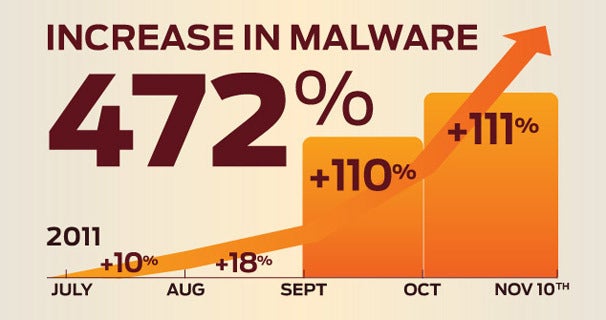
Android users take note: Researchers have found a whopping 472 percent increase in Android malware samples since this summer. The free-for-all Android et has seen a striking increase in the volume of attacks since ly, according to research from niper Networks, as attackers continue to become more sophisticated in the malware they write.
October November saw the fastest growth in Android malware discovery ever since ’s OS was launched, niper Global Threat Center found. The researchers identified a 28 percent increase in malware samples in September, which exploded to a 110 percent increase in October, a further 111 percent in November. The numbers are even more alarming, considering niper also reported a 400 percent spike in Android malware from 2009 to the summer of 2010.
The majority of these malicious Android apps (55 percent) usually target personal information stored on phones, while some 44 percent are SMS Trojans that send background SMS messages to premium rate numbers owned by the attacker. niper believes the people behind these malware apps are the same ones who wrote malicious code for older versions of ndows Mobile Symbian, but have since moved to Android, given the 43 percent of the mobile OS market it comms the open nature of the Android et.
The problem seems to be on the user-side of things, too. According to a study this summer, Android users are the least aware of security concerns least prepared to protect their phone from malware; four out of 10 users haven’t done anything to secure their phone, less than half of Android users lock their devices with a password.


Open vs. closed
The Android malware debate will inevitably lead to comparisons with Apple’s tightly-controlled iOS, which has its own security weaknesses, too. For Android, any ill-intended developer can just pay a $25 fee can post applications to the main Android market, without any review process to check if the apps actually do what they claim to.
Coupled with user negligence, Android’s malware problem is growing, which is why some Android devices manufacturers such as Amazon, Barnes & Noble others are creating their own curated Android app stores, fashioned after Apple’s iOS walled garden.
does indeed yank malware apps when they are reported, as it has been doing throughout the year, but that does not seem to have stopped the surge in attacks on the platform. Meanwhile, my colleague ley has five tips to avoid malware on your phone.


















